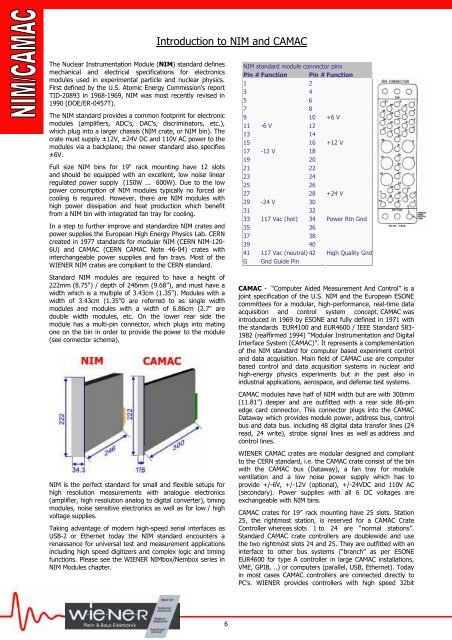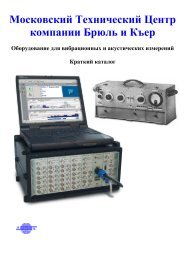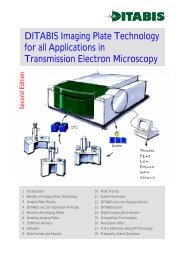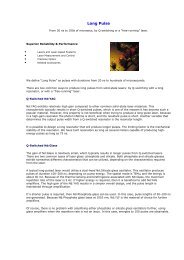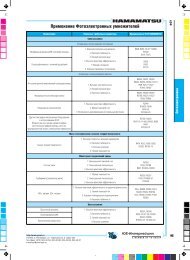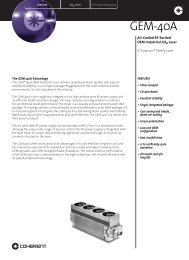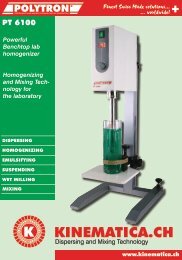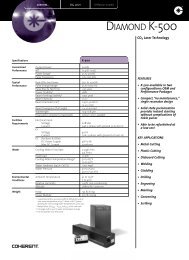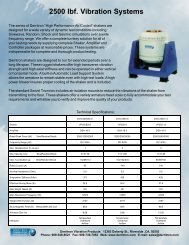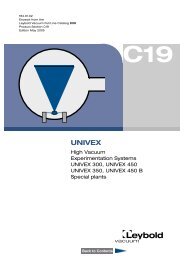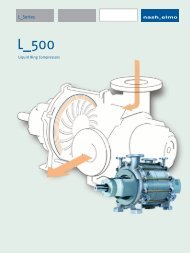6U VME 6023 Crate Series
6U VME 6023 Crate Series
6U VME 6023 Crate Series
You also want an ePaper? Increase the reach of your titles
YUMPU automatically turns print PDFs into web optimized ePapers that Google loves.
Introduction to NIM and CAMAC<br />
The Nuclear Instrumentation Module (NIM) standard defines<br />
mechanical and electrical specifications for electronics<br />
modules used in experimental particle and nuclear physics.<br />
First defined by the U.S. Atomic Energy Commission's report<br />
TID-20893 in 1968-1969, NIM was most recently revised in<br />
1990 (DOE/ER-0457T).<br />
The NIM standard provides a common footprint for electronic<br />
modules (amplifiers, ADC’s, DAC’s, discriminators, etc.),<br />
which plug into a larger chassis (NIM crate, or NIM bin). The<br />
crate must supply ±12V, ±24V DC and 110V AC power to the<br />
modules via a backplane; the newer standard also specifies<br />
±6V.<br />
Full size NIM bins for 19" rack mounting have 12 slots<br />
and should be equipped with an excellent, low noise linear<br />
regulated power supply (150W ... 600W). Due to the low<br />
power consumption of NIM modules typically no forced air<br />
cooling is required. However, there are NIM modules with<br />
high power dissipation and heat production which benefit<br />
from a NIM bin with integrated fan tray for cooling.<br />
In a step to further improve and standardize NIM crates and<br />
power supplies the European High Energy Physics Lab. CERN<br />
created in 1977 standards for modular NIM (CERN NIM-120-<br />
<strong>6U</strong>) and CAMAC (CERN CAMAC Note 46-04) crates with<br />
interchangeable power supplies and fan trays. Most of the<br />
WIENER NIM crates are compliant to the CERN standard.<br />
Standard NIM modules are required to have a height of<br />
222mm (8.75") / depth of 246mm (9.68”), and must have a<br />
width which is a multiple of 3.43cm (1.35"). Modules with a<br />
width of 3.43cm (1.35"0 are referred to as single width<br />
modules and modules with a width of 6.86cm (2.7" are<br />
double width modules, etc. On the lower rear side the<br />
module has a multi-pin connector, which plugs into mating<br />
one on the bin in order to provide the power to the module<br />
(see connector schema).<br />
NIM is the perfect standard for small and flexible setups for<br />
high resolution measurements with analogue electronics<br />
(amplifier, high resolution analog to digital converter), timing<br />
modules, noise sensitive electronics as well as for low / high<br />
voltage supplies.<br />
Taking advantage of modern high-speed serial interfaces as<br />
USB-2 or Ethernet today the NIM standard encounters a<br />
renaissance for universal test and measurement applications<br />
including high speed digitizers and complex logic and timing<br />
functions. Please see the WIENER NIMbox/Nembox series in<br />
NIM Modules chapter.<br />
NIM standard module connector pins<br />
Pin # Function Pin # Function<br />
1 2<br />
3 4<br />
5 6<br />
7 8<br />
9 10 +6 V<br />
11 -6 V 12<br />
13 14<br />
15 16 +12 V<br />
17 -12 V 18<br />
19 20<br />
21 22<br />
23 24<br />
25 26<br />
27 28 +24 V<br />
29 -24 V 30<br />
31 32<br />
33 117 Vac (hot) 34 Power Rtn Gnd<br />
35 36<br />
37 38<br />
39 40<br />
41 117 Vac (neutral) 42 High Quality Gnd<br />
G Gnd Guide Pin<br />
CAMAC - “Computer Aided Measurement And Control” is a<br />
joint specification of the U.S. NIM and the European ESONE<br />
committees for a modular, high-performance, real-time data<br />
acquisition and control system concept. CAMAC was<br />
introduced in 1969 by ESONE and fully defined in 1971 with<br />
the standards EUR4100 and EUR4600 / IEEE Standard 583-<br />
1982 (reaffirmed 1994) “Modular Instrumentation and Digital<br />
Interface System (CAMAC)”. It represents a complementation<br />
of the NIM standard for computer based experiment control<br />
and data acquisition. Main field of CAMAC use are computer<br />
based control and data acquisition systems in nuclear and<br />
high-energy physics experiments but in the past also in<br />
industrial applications, aerospace, and defense test systems.<br />
CAMAC modules have half of NIM width but are with 300mm<br />
(11.81”) deeper and are outfitted with a rear side 86-pin<br />
edge card connector. This connector plugs into the CAMAC<br />
Dataway which provides module power, address bus, control<br />
bus and data bus. including 48 digital data transfer lines (24<br />
read, 24 write), strobe signal lines as well as address and<br />
control lines.<br />
WIENER CAMAC crates are modular designed and compliant<br />
to the CERN standard, i.e. the CAMAC crate consist of the bin<br />
with the CAMAC bus (Dataway), a fan tray for module<br />
ventilation and a low noise power supply which has to<br />
provide +/-6V, +/-12V (optional), +/-24VDC and 110V AC<br />
(secondary). Power supplies with all 6 DC voltages are<br />
exchangeable with NIM bins.<br />
CAMAC crates for 19” rack mounting have 25 slots. Station<br />
25, the rightmost station, is reserved for a CAMAC <strong>Crate</strong><br />
Controller whereas slots 1 to 24 are “normal stations”.<br />
Standard CAMAC crate controllers are doublewide and use<br />
the two rightmost slots 24 and 25. They are outfitted with an<br />
interface to other bus systems (“branch” as per ESONE<br />
EUR4600 for type A controller in large CAMAC installations,<br />
<strong>VME</strong>, GPIB, ..) or computers (parallel, USB, Ethernet). Today<br />
in most cases CAMAC controllers are connected directly to<br />
PC’s. WIENER provides controllers with high speed 32bit<br />
6


